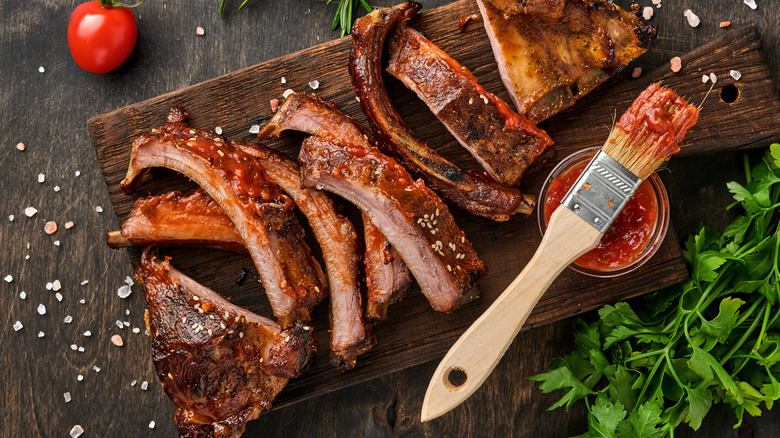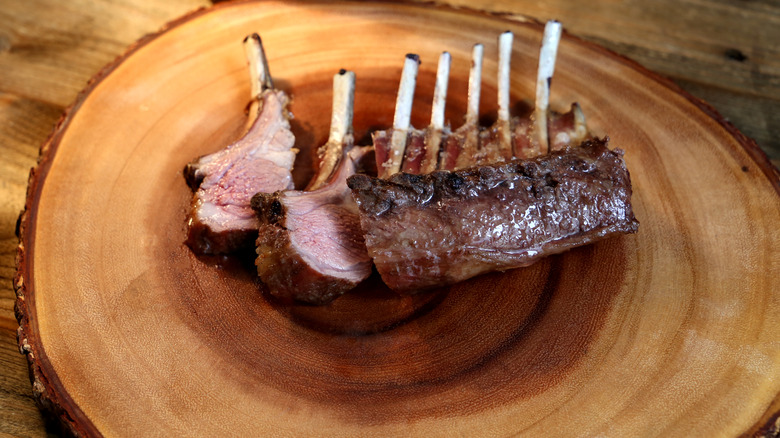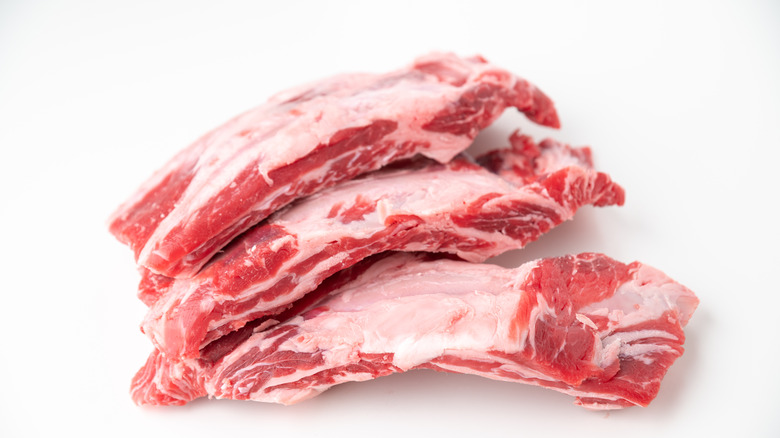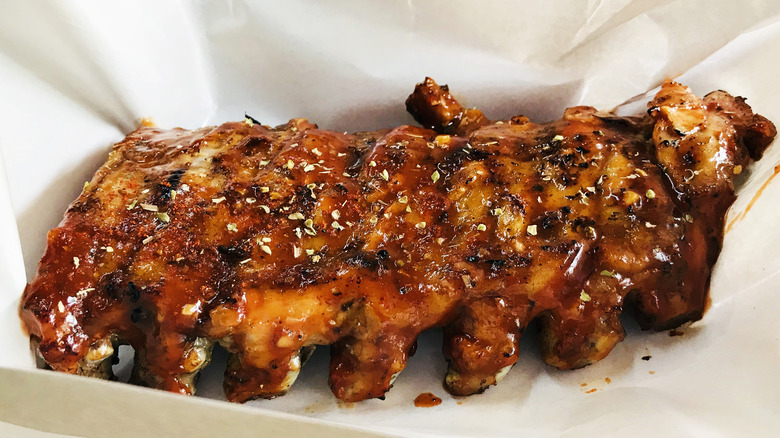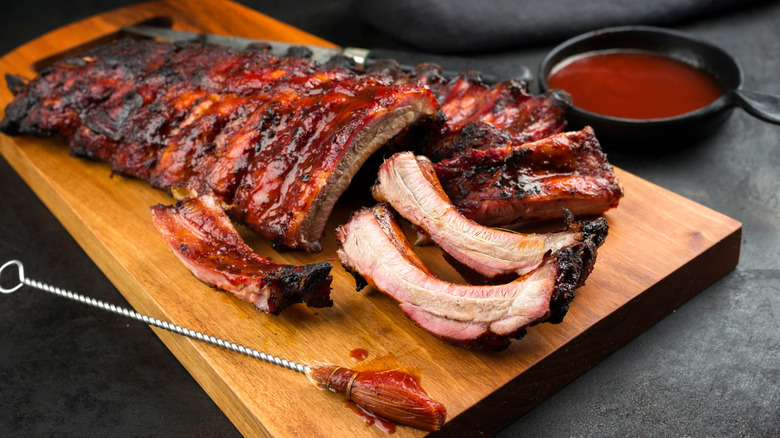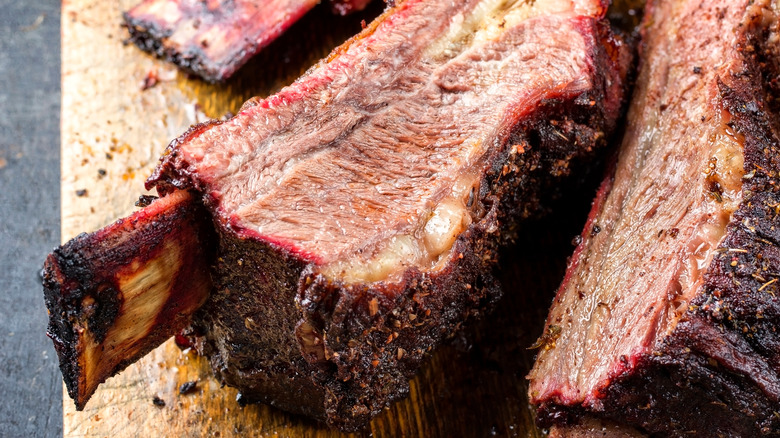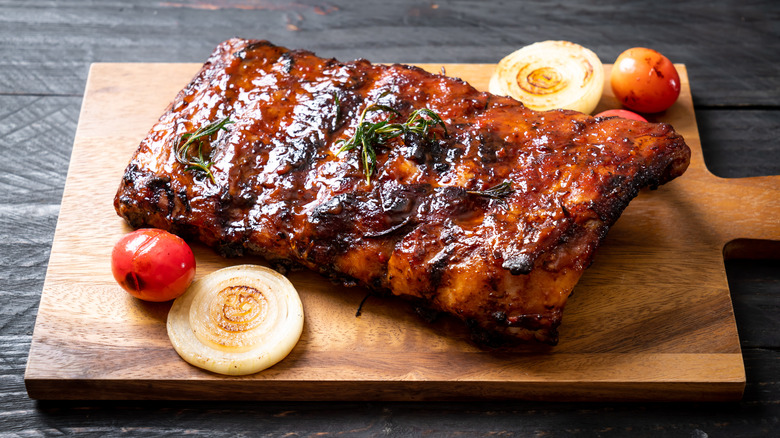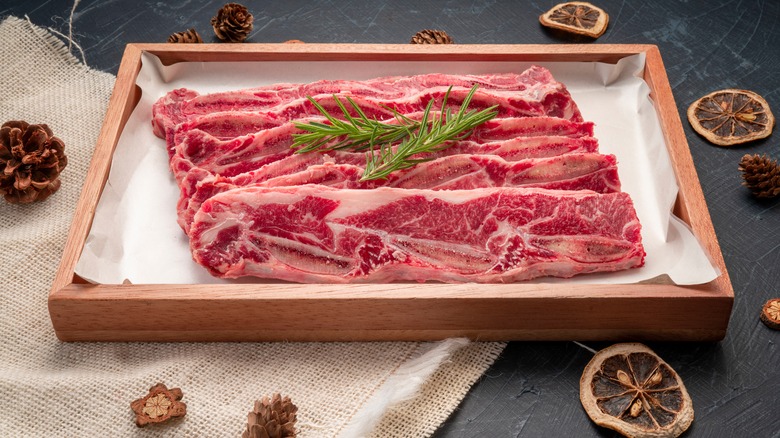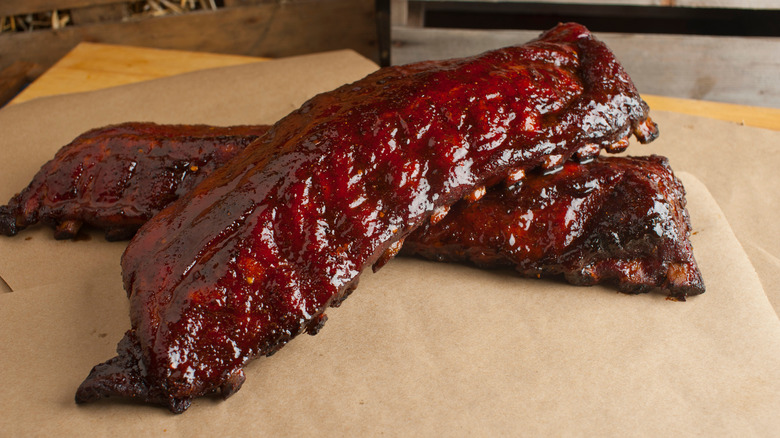Ranking Every Cut Of Ribs, From Worst To Best
Whether it be beef, pork, chicken, lamb, or game, if you're a meat lover, then you've probably got a favorite cut. The same can be said for ribs, because — depending on the specific areas from which they are taken — not all cuts of ribs are made equal.
Ribs were popularized during the 19th century when the barbecue became the customary way of feeding large groups of people during community gatherings. Unlike today when ribs can be ordered as a standalone dish with its own set of sides, ribs were historically served as only one part of a whole animal that was prepared to feed large numbers of people. Over time, with the rise of meatpacking and mechanical refrigerators, ribs became increasingly available to smaller groups of people and establishments.
By the time the 20th century rolled around, the U.S. was becoming more urbanized, and with that, more street food stands offered barbecued meats, including ribs. Some of these street food stalls morphed into formal restaurants, leading to the commercialization of barbecues and ribs. They were a hit "particularly in cities with a large African-American community, where ribs were sold at nightclubs," says Felix BBQ. "Owners would set up small barbecue pits behind their clubs and ribs would be cooked and sold to hungry nightclub-goers."
Today, one doesn't need to rely on community gatherings, restaurants, food stands, or nightclubs for a good rack of ribs. Armed with the right information and a good butcher, you could have a bash at your favorites in your very own home. Read on to see how different cuts of ribs rank in comparison to others.
8. Lamb riblets
Sometimes called riblets or lamb rack, lamb ribs are little, fleshy pieces of meat around small bones. The meat relies heavily on the fat and connective tissue for its flavor. They are not particularly popular in the United States, and are largely surpassed by beef and pork ribs in many parts of the world where ribs are popular. These ribs, which are cut near the shoulder by the breast area, are not very big relative to the other cuts listed here.
It's worth noting that the USDA only considers meat to be lamb if the sheep was less than a year old. However, it's unclear how strictly this is enforced. As such, you may have to check with your butcher before purchase. Ultimately, if all you're after is that specific note of lamb flavor in your ribs, these may be a good choice. However, if you're looking for the saucy, sticky goodness of more traditional ribs, you're better off going with beef or pork.
7. Beef back ribs
A lot of people think of pork when they hear the word ribs, and of all beef ribs, back ribs are often the most forgotten about. This could be to do with their location — they are taken from the dorsal area on the cow, which is where the prime rib roast and ribeye steak cuts come from. The back ribs are essentially the ragged pieces that are left exposed once these coveted cuts are removed. They're about eight inches in length and you'll likely notice a bit of a curve on them.
The meat on this rib cut rests between the bones rather than on top of them, and they are quite lean in comparison to other ribs. This is not to say the sparse meat on beef back ribs denotes lack of quality. While other cuts of ribs are meatier, beef back ribs boast a high bone marrow content that makes them especially great for stews or soups, as well as smoking and braising. However, while beef back ribs can work well, they have to be cooked exactly right, and even when they are, they're not the tastiest ribs out there.
6. Rib tips (pork)
Speaking of ragged pieces and butcher's scraps, next on our list is rib tips. This cut has roots in Chicago, where the locals decided to try something with them rather than throwing them away. "Around the turn of the 20th century, Chicago was one of the largest meat processing and packing cities in the U.S.," says The Bearded Butchers. "At the time, rib tips were considered waste and were discarded." In the Southside area of the city, people decided to smoke them with plenty of barbeque sauce, and the rest is history. Rib tips are known all across the United States and beyond, but what are they, exactly?
They tend to be about one to three inches wide, and eight to 12 inches long. What's unique about rib tips is that, unlike other ribs (which are expectedly boned), rib tips have no bone. Instead, there's a thick layer of cartilage. They're found on the lower end of pork spare ribs: Once this part of the pork spare ribs is removed, what remains are the St. Louis-style ribs.
Rib tips can work well in sweet and sour sauce, and black bean rib tips are pretty tasty. They can also be used in adobo, a sauce that's often used to marinade other meats and seafood. Because of their close proximity to the belly, rib tips can be quite flavorsome. In addition, they are more marbled than other cuts and hold quite a bit of fat. Fat and flavor are always a good thing when it comes to ribs, but contending with a big chunk of cartilage is not really what rib dreams are made of.
5. St. Louis-style ribs (pork)
There was a big boom in meatpacking during the 19th century. The rise of the St. Louis-style barbecue is owed to its namesake city, which, together with Kansas, served as a prominent meatpacking town during the boom. With this came the opening of some of the first barbecue restaurants in the United States. By the 1930s, St. Louis-based meatpackers started to remove the cartilage from pork spare ribs, creating a rectangular cut that they named St. Louis ribs. What sets the St. Louis-style barbeque apart from others is that the meat is first grilled and sauced thereafter.
It's important to remember that the name "St. Louis-style ribs" refers not to the method of preparation, but to the specific way in which the ribs are cut. More specifically, St. Louis-style ribs are what you have left after the rib tips are removed from pork spare ribs. Without the cartilage, they are easier to cut and easier to eat, and even though the meat on them is not particularly tender, when made the St. Louis barbecue way, they are flavorsome.
4. Chuck short ribs (beef)
Chuck short ribs are cut from the shoulder area and are more commonly called beef ribs, braised ribs, or just short ribs. This cut is usually made up of the first four or five ribs. This means straight bones and a decent chunk of meat, making them the most popular cut of beef ribs.
Because of the meatiness and short bones, chuck short ribs are easy to eat and they lend themselves well to both grilling and smoking. However, the size of the bones makes this cut a little deceiving: It can appear as if there's more meat than there actually is. Still, with this cut, you're usually looking at a good two inches of meat per rib.
Chuck short ribs are always tasty if done right, and that's hardly surprising considering where they come from. This cut's proximity to an area from which tender roast and steak cuts are taken means that it boasts a similarly tender texture and beefy taste.
3. Spare ribs (Pork)
For most people, spare ribs are what come to mind when rib cuts come up in conversation. It's safe to say this cut is among the most well-known and the most-loved, and with good reason. Spare ribs are in good company: St. Louis-style ribs are synonymous with spare ribs as they are both cut from the spares, near the pork belly. "They're close to the same thing and are mostly treated the same during cooking," says to Food Fire Friends. "Smoking them low 'n' slow makes them easy to eat and unleashes a ton of rich flavor."
So why do spare ribs (also known as side ribs or simply spares) outrank both St. Louis-style ribs and the rather similar rib tips? That's because spare ribs are basically a combination of the two, giving diners the best of both worlds. While the meat isn't known for its tenderness, when smoked, it's delicious and practically falls off the bone. Perhaps the only reason people avoid them is they're not sure how many they're going to need. "Spare ribs tend to weigh in at an average of around three pounds per slab," explains Smoked BBQ Source. "A slab of spare ribs should be plenty for two — while it may look like a lot, bear in mind that half or a little more is bone."
2. Plate short ribs (beef)
If you're into ribs, you've probably heard of short ribs. This usually refers to plate short ribs, otherwise known as dino ribs or flanken ribs. They are taken from the middle of the rib cage, on the short plate where ground beef and skirt steak is also sourced. They're similar to chuck ribs, but they're meatier and a dream to smoke as a result, explains The Online Grill. "Plate short ribs are perhaps the daddy of all beef ribs. They are big, meaty, and beautifully tender when fresh off the smoker."
The flavor of plate short ribs is enhanced by the cut's high fat content. They need to be left on the smoker for several hours, but this is when the magic happens — as the meat smokes, the fat breaks down slowly, which not only adds a buttery richness but also keeps the meat moist. The only reported downside of this cut has nothing to do with the cut itself: It's often found at specialized butchers, so you may struggle to find it at your local supermarket or meat store. If you're willing to do the proverbial hunt, you'll be rewarded with the best rib cut there is — bar one.
1. Baby back ribs (pork)
The first thing to know about baby back ribs is that they get their name because they're smaller than spare ribs, not because they come from baby pigs. They are naturally tender, and this makes them far easier to cook. This (along with some super secret seasoning) is part of what makes Chili's baby back ribs so delicious.
Another great thing about baby back ribs is that they are cut close to the pork loin. As a result, they tend to be meatier than spare ribs, and you won't find as many "shiners," which are ribs cut too close, exposing the bone. There's also the added bonus of having next to no cartilage to contend with. They're lean, they're meaty, and there's no better rib cut.
